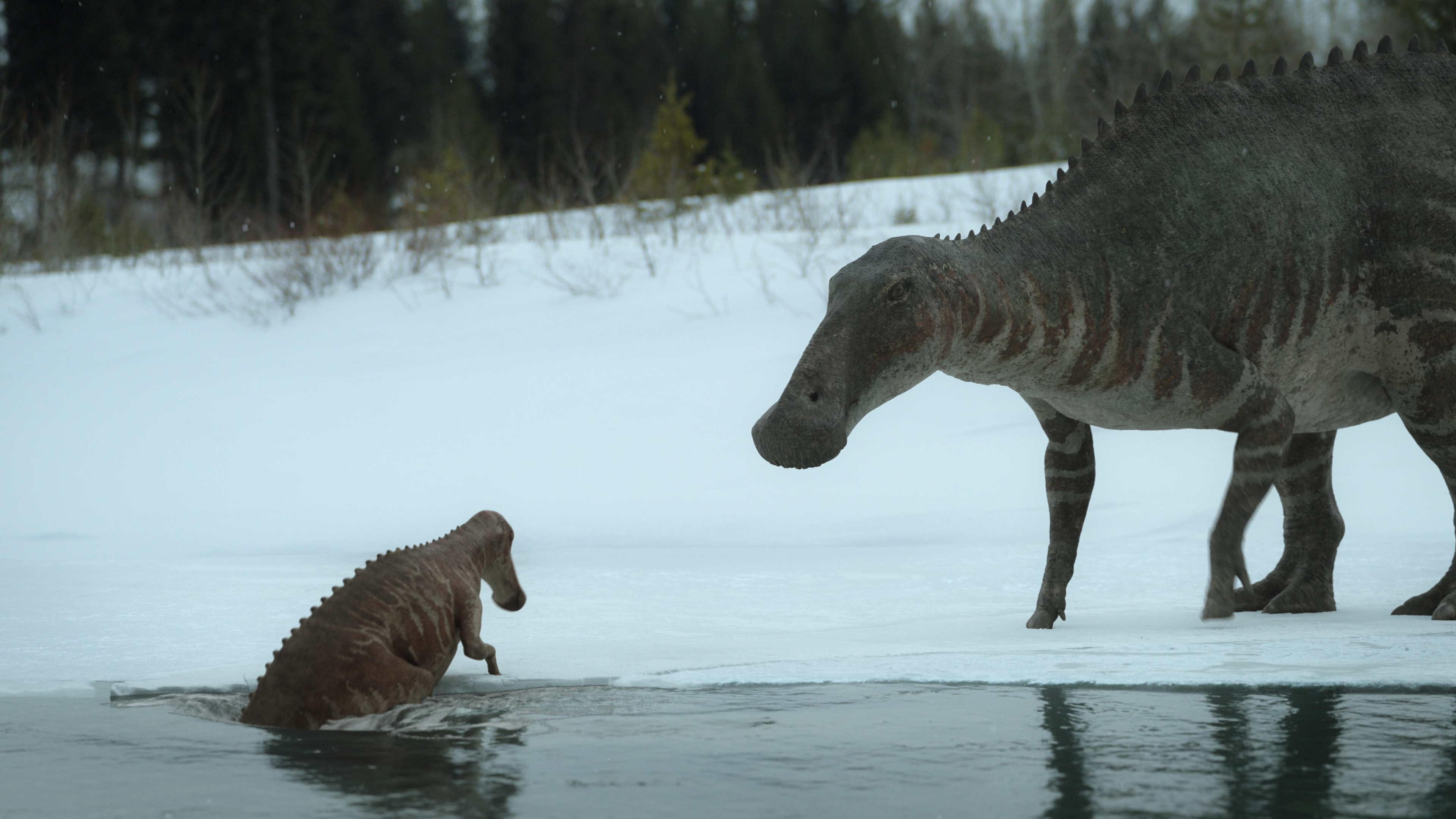Dinosaurs took over the planet because they could endure the cold, scientists say
Their adaptation to cold environments gave them an edge during an early extinction event.

Dinosaurs took over the planet thanks to their surprising ability to endure freezing-cold temperatures, ancient footprints have revealed.
The dinosaur tracks, stamped into the sandstone and siltstone of ancient lake beds in the Junggar Basin of northwestern China, suggest that more than 200 million years ago, the reptiles had already adapted to survive the cold of the polar regions before a mysterious mass extinction event plunged the world into freezing darkness.
Dinosaurs first appeared in temperate southerly latitudes roughly 231 million years ago during the Triassic period (around 252 million to 201 million years ago), back when Earth's continents were still joined together to form a supercontinent called Pangea. By around 214 million years ago, dinosaurs had spread northwards toward Arctic regions, but they still remained a minor group compared to other species on Earth — such as the ancestors of modern crocodiles that ruled over the tropics and subtropics, scientists reported in a new study. At the time of Pangea, the Junggar Basin was about 71 degrees north of Earth's equatorial plane, falling comfortably within the Arctic Circle.
Related: How did 'Prehistoric Planet' create such incredible dinosaurs? Find out in a behind-the-scenes peek.
Then, 202 million years ago in an episode called the Triassic-Jurassic extinction event, a chain of massive volcanic eruptions cooled the planet dramatically, killing more than 75% of species on land and in the oceans, and paving the way for the cold-adapted dinosaurs to emerge from the Triassic period and dominate the Jurassic (around 201 million to 145 million years ago), researchers explained in a study published July 1 in the journal Scientific Advances.
"Dinosaurs were there during the Triassic under the radar all the time," lead author Paul Olsen, a professor of biology and paleo environment at Columbia University's Columbia Climate School in New York City, said in a statement. "The key to their eventual dominance was very simple. They were fundamentally cold-adapted animals. When it got cold everywhere, they were ready, and other animals weren't."
Footprints in the basin in China, imprinted along the shorelines of shallow lakes that were once there, confirmed the presence of dinosaurs in the freezing region. The researchers also found small pebbles within the usually fine-grained sediments that they identified as ice-rafted debris — rocky material that winter ice sheets had carried from the shore out to the middle of the lake, depositing them there when the sheets melted in summer.
Sign up for the Live Science daily newsletter now
Get the world’s most fascinating discoveries delivered straight to your inbox.
"This shows that these areas froze regularly, and the dinosaurs did just fine," study co-author Dennis Kent, an adjunct senior research scientist and geologist at Columbia University's Lamont-Doherty Earth Observatory, said in the statement.
All this evidence suggests that dinosaurs didn't just survive freezing weather — they thrived in it, leaving them well placed to become the undisputed rulers of the planet by the end of the Triassic. But how did they do it? Prior research has suggested that many dinosaur groups were warm-blooded and had high metabolisms, and a growing body of evidence hints that many non-avian dinosaurs had a special kind of insulation that their cold-blooded crocodilian cousins lacked: feathers.
"Severe wintery episodes during volcanic eruptions may have brought freezing temperatures to the tropics, which is where many of the extinctions of big, naked, unfeathered vertebrates seem to have occurred," Kent said. "Whereas our fine feathered friends, acclimated to colder temperatures in higher latitudes, did OK."
The researchers' findings defy the popular notion of dinosaurs as animals that could only survive in warm climates, Stephen Brusatte, a professor of paleontology and evolution at the University of Edinburgh in Scotland, who was not involved in the research, said in the statement.
"There is a stereotype that dinosaurs always lived in lush tropical jungles, but this new research shows that the higher latitudes would have been freezing and even covered in ice during parts of the year," Brusatte said. "Dinosaurs living at high latitudes just so happened to already have winter coats [while] many of their Triassic competitors died out."
Now that the researchers have documented signs that dinosaurs inhabited these chilly regions, they plan to look for more difficult-to-find fossils in former polar areas, to shed more light on how the ancient reptiles lived there.
"Most paleontologists are attracted to the late Jurassic, where it's known there are many big skeletons to be had," Olsen said. "The paleo-Arctic is basically ignored."
Originally published on Live Science.

Ben Turner is a U.K. based staff writer at Live Science. He covers physics and astronomy, among other topics like tech and climate change. He graduated from University College London with a degree in particle physics before training as a journalist. When he's not writing, Ben enjoys reading literature, playing the guitar and embarrassing himself with chess.









